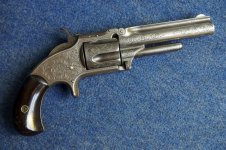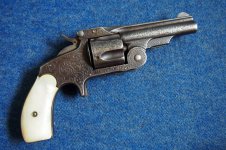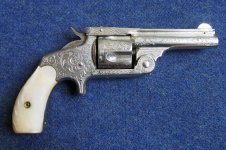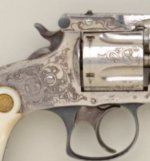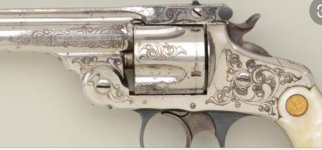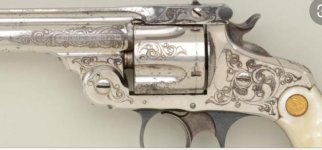If S&W Factory engraving was anything like the other mfg'rs of the time, they were quite strict about what went on a piece as far as a cataloged pattern.
The layout, amt of coverage coverage you recv'd for your pick of a certain # or Letter grade engraving pattern at a standard cost was set.
It was so as the Engraver was allowed just so many hours of time to complete each of those patterns. Small variances in time due to bbl length differences and other small changes from gun to gun that are normal would apply.
But the factorys kept a pretty close handle on the financial end of how much they paid for the services of the Engraver. Didn't matter if they were a Factory in house employee or the piece to be sent out to be engraved.
Many of the old factory patterns still in existance or photos of them will show dollar amts to be paid for the labor and also the time allowed in hours for the engraver if an 'in house' job.
The engraver isn't going to lavish much of their free time on a job for no pay when another paying job is sitting at the end of their bench.
The Factory is only expecting the Factory #-whatever pattern on it,,that's what they got in most instances.
Small differences from that # pattern show up. That's just to be expected as it's a hand done operation. Adding in a touch here or there, making a line or border extend or criss-cross is a couple seconds off the clock.
Some times it's just easier for you to do some small differences with your particular style of cutting than to doggedly follow another persons drawing or pattern.
It breaks the monotony too if you have a stack of these to do, all the same.
Then to all this add the difference that each individual engraver and the way they cut brings to the pattern.
Give ten engravers the same simple scroll pattern to layout and cut.
The result will be 10 examples that look similar but not the same. It's just a natural result of hand movement using the tools and the tools themselves, how each sharpens them, RH or LH, standing or sitting while working, calm settled nerves or a young man or woman,,or the shaking hands of an elder engraver trying to stay in the game. Lots of things to consider.
You may even see 2 examples of the same persons work, one from early in their career and another from late(r) in their working career. Same person and the work looks entirely different.
The Experts may place those two pieces under 2 entirely different persons volumes of work sometimes. They look different..
But people change. They have accidents and illnesses. Eyesight fails, alcohol addiction, they may hate their job. Lots of things play into changes in the look of one persons work which may easily cover 60+ years in the trade.
No one starts out being the MeisterGraver
Not engraving for the Factory, and not being restricted to a set of patterns pre selected and w/time limits, an outsourced engraver doing NY style engraving is freed of alot of restraints.
That style scroll is usually much larger. It's easy to cut, fast to cut and fill in space. Results can be more coverage for less time ($$),
It is easier in most instances to fill in the entire side plate on say the revolver with that larger style scroll and it's large beaded background and liner shading (something you can cut while your mind wanders to other things), than it is to carefully center and cut a partial coverage pattern on the same surface with a smaller scroll more delicate in shape and detail.
In NY Style engraving, the use of wriggle cuts to cover odd shaped spaces here and there are common as well as star burst type brite cuts.
Combining the two is also used.
Colt engraving used this alot.
I think if you look at the factory patterns offered, they are a bit more restrained than the NY style. Less use of any quicky coverage cuts like the wriggle or heavy large open bead dot back ground.
It's not a Black and White sure fire way to tell one from the other of course.
Thats what those factory letters are good for.

